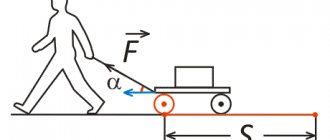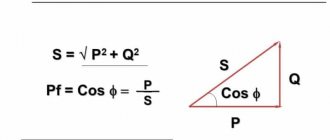What is “dedicated electrical power”?
If we explain the meaning of this term in simple language, then the allocated (or permitted) power is the maximum permissible load on the consumer’s network. It is established in accordance with current standards and is indicated in the electricity supply contract.
Those who want to understand this issue in detail should have an idea of connected, installed, one-time and permitted capacity. Let's give a brief definition of each of them:
- Connected , this term means the total installed power of all electrical receivers powered from the consumer's network.
- Installed - rated active power specified in the technical documentation for electrical equipment, that is, that at which consumer devices will operate in normal mode.
- One-time – the estimated amount of power consumption of electrical installation equipment for a certain time.
- Allocated (allowed) – the maximum one-time power that a consumer can connect to the energy supply company’s network. This parameter is indicated in the specifications for connecting energy-receiving facilities and in the agreement between the consumer and the organization supplying electricity.
Conditions for transferring maximum power from the energy source to the receiver
Overhead Line > AC Circuits. Theory.
Conditions for transferring maximum power from an energy source to a receiver Let's imagine an energy source with EMF E and internal resistance by an equivalent circuit (Fig. 3.22). Let's find out what the resistance Z=r + jx of the receiver should be so that the active power transmitted to it is maximum. Receiver power Obviously, for any r, the power reaches its greatest value at . In this case, taking the derivative with respect to r from the resulting expression and equating it to zero, we find that P has the greatest value at . Thus, the receiver receives the greatest active power from the source if its complex resistance is conjugate with the complex internal resistance of the source: Under this condition and efficiency In electric power plants, the maximum power transmission mode is unprofitable due to significant energy losses. In various types of automation, electronics and communications devices, the signal powers are very low, so it is often necessary to specially create conditions for transmitting the maximum possible power to the receiver. A decrease in efficiency often does not matter at all, since the transmitted energy is small. Matching the resistances of the receiver and the power source in accordance with (3.50) can also be achieved by adding elements with reactance to the circuit (see example 4.6). Sometimes the resistance of the receiver can be changed without arbitrarily, but only with maintaining the relationship between active and reactance, i.e. at . An analysis, which is not given here, shows that in this case the power P is maximum if the impedances of the receiver and the source () are equal to each other, while matching the impedances of the receiver and the power source can be achieved by turning on the receiver through a transformer. In the general case of a receiver - a branched passive circuit - Z is its input impedance.
See also the section on websor
- Alternating currents
- Concept of alternators
- Sinusoidal current
- Effective current, emf and voltage
- Representation of sinusoidal functions of time by vectors and complex numbers
- Addition of sinusoidal time functions
- Electrical circuit and its diagram
- Current and voltage when connecting resistive, inductive and capacitive elements in series
- Resistance
- Voltage and current phase difference
- Voltage and currents when connecting resistive, inductive and capacitive elements in parallel
- Conductivity
- Passive two-terminal network
- Power
- Powers of resistive, inductive and capacitive elements
- Power balance
- Power signs and direction of energy transfer
- Determining the parameters of a passive two-terminal network using an ammeter, voltmeter and wattmeter
- Conditions for transferring maximum power from the energy source to the receiver
- Understanding the Surface Effect and the Proximity Effect
- Parameters and equivalent circuits of capacitors
- Parameters and equivalent circuits of inductors and resistors
What are the dangers of exceeding the permitted power?
Currently, when it detects that the maximum load has been exceeded, the electric company introduces a consumption limitation mode. The basis for this is a violation of the obligations specified in the energy supply agreement. As a rule, limiting consumption is turning off the electric current. The algorithm for sending such a notification is shown in the figure.
Example of a consumer notice
After 10 days after sending the notice, the company disconnects the power supply. To avoid this, the consumer must eliminate the violation within ten days, and then contact the service provider to draw up the appropriate report. Electricity supply will be restored after the electric company pays the penalty in accordance with the contract.
More serious consequences may arise if, in addition to violating the amount of allocated energy, an accusation of uncontrolled electricity consumption is brought forward. The basis for this will be the removal of seals from the input machine. You can get more detailed information about the consequences of uncontrolled electricity consumption, electricity metering rules, etc. on our website.
Seal on the introductory machine (marked in red)
Document overview
The Procedure for forming a consolidated forecast balance of production and supply of electricity (capacity) within the Unified Energy System of Russia by region has been re-approved.
The objectives of creating a balance are to satisfy the demand for electricity and power, minimize the costs of their production and supply, ensure reliable energy supply, as well as balance the total cost of electricity and power supplied to the wholesale market at regulated prices (tariffs) and sold under regulated sales contracts (supplies) in price and non-price zones.
Balance is needed to achieve 3 goals. The first is the calculation of regulated prices (tariffs) for electricity and power, subject to state regulation, as well as regulated prices (tariffs) for services provided in the wholesale and retail markets. The second is the conclusion by participants of the wholesale market of agreements, on the basis of which the purchase and sale of electricity and (or) capacity is carried out on such a market. The third is the conclusion by producers (suppliers) of purchase and sale (supply) agreements for electricity and capacity with a supplier of last resort in regions united in non-price zones. We are talking about manufacturers (suppliers) who are subject to the legal requirement to sell produced electricity (power) only on the wholesale market and who, before receiving the status of a wholesale market entity, participate in purchase and sale relations on the retail market.
The Procedure for determining the ratio of the total annual forecast volume of electricity consumption by the population and equivalent categories of consumers to the volume of electricity corresponding to the annual average value of the forecast capacity determined in relation to these categories of consumers was also approved.
The ratio is established to determine the planned volumes of consumption by the population for the next regulated period based on the results of control measurements. They are carried out by guaranteeing suppliers, energy supply and sales organizations that supply electricity (power) to the population and equivalent categories of consumers in the year preceding the next regulated period.
The order approving the previous procedure for the formation of a consolidated forecast balance was declared invalid.
To view the current text of the document and obtain complete information about the entry into force, changes and procedure for applying the document, use the search in the Internet version of the GARANT system:
Rules and regulations
Electrification of any facility is carried out in accordance with the specifications developed by the company providing electricity supply services. One of the paragraphs of this document indicates the parameters of allocated power for the consumer network. The energy supply company forms technical specifications based on the declared capacity, justified by calculations.
When electrifying residential and public buildings, they are guided by SP 31 110 2003 and temporary instructions PM 2696 01. According to these documents, residential buildings belonging to the 1st category are not standardized in terms of power allocation. That is, if there is a technical possibility, then the technical specifications for connecting such facilities are formed on the basis of the submitted application.
For residential buildings of the 2nd category, two electrification standards are provided:
- 5 - 7 kW, for a private house or apartment, with gas stoves.
- 8 – 11 kW – with electric stoves.
At the same time, the lower threshold for power allocation is provided for small-sized apartments in houses built under the social housing program. Note that these standards were established relatively recently; for electrical installations of residential buildings built before 2006, they were lower.
Selection of the “Calm” voltage stabilizer model for home protection
So, having data on the allocated power, you can easily select a suitable voltage stabilizer model to protect the entire electrical system in the house.
When choosing a stabilizer model for centralized connection of electrical appliances, you need to pay attention to its technical capabilities. For example, it is important that the device has terminal blocks through which it can be easily connected to the mains.
The design should also be taken into account. If the stabilizer will be installed next to the electrical panel, then it must be able to be wall mounted. The noise level is important when installing the device in a residential area.
Selection according to the nominal value of the introductory machine
Stabilizer for single-phase network
For example, a 220 V network with a permissible output power of 5.5 kW is installed in a house with a 25 A input circuit breaker installed. In this case, wall-mounted IS7000 voltage stabilizer models with an output power of 7000 VA / 5000 W or IS1106RT for floor or rack installation are ideal with output power 6 kVA / 5.4 kW.
Stabilizer for three-phase network
Another example. A three-phase network of 380 V for 15 kW was installed in a private house. In this case, each phase accounts for 5 kW. Accordingly, three 25 A single-phase circuit breakers are installed in the electrical panel. In this case, there are several options to protect the entire electrical system of the house.
| Option | Description |
| 1) Installation of a single-phase stabilizer on each supply phase | If the house has only single-phase consumers, then the most convenient and functional option for providing protection would be to install one voltage stabilizer for each phase. For our case, the above IS7000 stabilizers for 7 kVA/5 kW or IS7000RT for 7 kVA/5.5 kW are also suitable. |
Selection depending on the total load power
You can also select the necessary voltage stabilizer model for centralized home protection based on the total power consumption of the load that is currently connected or planned in the future.
For example, in a house with a 220 V network, the following single-phase electrical appliances are installed, to which a voltage stabilizer must be connected:
| electrical appliance | Power consumption, in W |
| TV | 200 |
| Lighting (indoor and outdoor) | 1500 |
| Boiler | 1500 |
| Fridge | 1500 (including starting currents) |
| Microwave | 1500 |
| Total power | 6200 |
To this amount it is necessary to add a 30 percent margin (6200 x 1.3), since when the mains voltage drops, the output power of the stabilizer will decrease, which can lead to its overload and switching to bypass mode. Therefore, the required output power of the stabilizer will be at least 8000 W.
If you choose from the line of inverter voltage stabilizers of the InStab series, then single-phase models are well suited for this example:
- IS10000 10 kVA/9 kW for wall installation;
- IS10000RT 10 kVA/9 kW for floor or rack mounting.
How do you know how much power is allocated?
Those who do not know the amount of permitted power for a house or apartment can use the following ways to obtain information:
- Get a certificate from the energy supply company. It should be taken into account that such a service is considered paid; for example, at Mosenergosbyt you will have to pay from 1.3 to 3.1 thousand rubles for it, depending on the category of the residential property.
- Look for the required parameter in the energy supply contract or technical specifications.
- Obtain information empirically by looking at the parameters of the input protective device. The fact is that in most cases, in addition to its direct functions, it plays the role of a power limiter. To set its maximum value, it is enough to find out the operating current of the machine.
How many kilowatts can the wiring in the apartment withstand?
Table of cable power depending on the cross-section
Under ideal conditions, a standard copper conductor with a cross-section of 2.5 mm2 can withstand a load of 5.9 kW, and an aluminum conductor - 4.4 kW.
Under operating conditions, aluminum conductors of old houses with a cross-section of 2.5 mm2 can withstand 3.5 kW at a current of 16 A. APPVs of 6 mm2 do not burn out at a load of 5.5 kW and a current of 25 A. Wires with a cross-section of 4 mm2 will withstand 4, 4 kW at current 25 A.
According to the rules of the PUE, a three-core copper wire with a cross-section of 1.5 mm2 must withstand a maximum permissible load of 5.9 kW. 4 mm2 cable – 8.3 kW with a current of 28 A. Conductor with a cross-section of 6 mm2 with a current of 46 A – 10.1 kW.
Calculation of required power
This calculation will be needed to understand whether the amount of allocated electrical power for an apartment or house will be sufficient. To do this, you will need to calculate the maximum load by summing up the corresponding parameters of all consumer electrical installations. Moreover, it is necessary to take into account all household electrical appliances that can be turned on at the same time.
As a rule, all the necessary information is indicated on a sticker affixed to the equipment body or is given in the documentation. If the sticker has become unreadable and the technical data sheet has been lost, you can use the table that shows the typical active power of household equipment.
Table of approximate power consumption of various household appliances
Having calculated the total consumption, do not rush to consider the work completed; it is necessary to add a reserve, taking into account a possible increase in load over time. As a rule, the size of the reserve is set at 20-30% of the calculated parameters.
By adding these two values, we get a result that can be compared with the allowed power. If it turns out to be less than the calculated load, it makes sense to think about applying for an additional 1 kW or 3 kW. Details about adding additional kilowatts will be discussed below.
Recommendations for the manager
What should an employer do if he wants to change production capacity for the better? Let's look at specific examples:
- Providing additional jobs.
- Elimination of unreasonable waste of time.
- Incentivizing employees to increase productivity.
- Improvement of employee qualifications.
- Equipping workplaces with modern technology.
- Improving the structure of fixed assets.
- Organization of measures to reduce raw material consumption rates.
Enterprises with obsolete and technically obsolete equipment have the lowest production capacity.
How to increase the allocated power?
Unfortunately, electrical energy consumption standards do not keep pace with the growth of active load. More and more household energy-receiving devices are appearing in residential premises, the simultaneous operation of which triggers the thermal protection of the input AV. There are only two ways out of this situation:
- Reduce household consumption by refusing to operate a piece of equipment at a time, which may cause some discomfort.
- Contact your electricity supplier for additional capacity.
Since consuming less electricity is not an option, the last option is the most rational. Let's consider how to increase the amount of electricity for individuals and legal entities. Let's start with the first ones.
For a private person
The algorithm of actions can be divided into the following stages:
- Preparation of necessary documents.
- Drawing up a project for the electrification of a residential building.
- The process of coordinating the developed project with the company providing services regarding the possibility of technological connection or increasing electrical power.
- Approval of the project by the local Energonadzor authority.
- Inspection of the electrical installation, followed by drawing up a corresponding report and approval certificate confirming the readiness of the facility for operation under new conditions of power supply to power-receiving installations. The report is drawn up by an employee of the electric company, and the approval certificate is drawn up by a representative of Energonadzor.
- The completed documents are sent to the electric company, after which it increases the permissible load (power allocated).
Now we list the package of necessary documents; they are almost identical to those needed when connecting electricity:
- Documents of the owner of a residential building confirming his identity and rights to real estate.
- Help indicating the current value of the electrical load. As mentioned above, it must be obtained from the electricity supply company.
- An agreement with a service provider, which specifies the cost of electricity and the current volume of its consumption.
- The act of delineating operational responsibilities.
Fragment of a standard act of delineation of book value - Floor plan and electrification project. If you order it, you will have to pay about $200 - $1000 for it.
As a rule, the company developing the project simultaneously offers services for its implementation. In some cases, it makes sense to use their help so as not to waste time.
for Individuals:
1. Layout of power receiving devices (ERDs) that need to be connected to the electrical networks of the network organization. The plan contains information about the geographical location of the site on which the EPU are (will be) located. 2. List and power of energy receiving devices. 3. Documents confirming the ownership or other basis provided by law for a capital construction project and (or) the land plot on which (in which) the applicant’s objects are located (will be located), or the right of ownership or other basis provided by law for energy receiving devices (provided in one copy in the form of a simple copy. In the case of shared participation in the rights to an object, land plot or power receiving devices, written consent of the remaining owners or their authorized person is provided for the execution of documents on technological connection in the name of the applicant and the implementation of the necessary technical measures in relation to the common property. 4. If an application is submitted through a representative, a power of attorney or other documents confirming the authority of the applicant’s representative (submitting or receiving documents).











